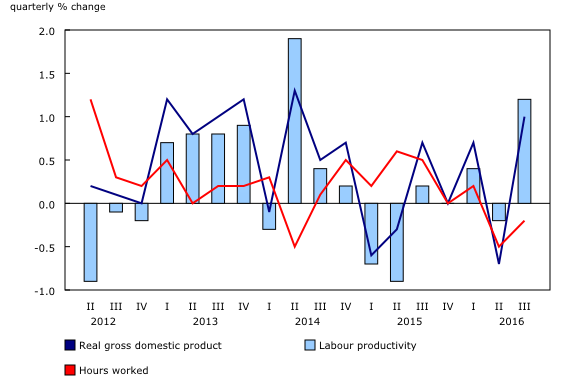Labour productivity, hourly compensation and unit labour cost, third quarter 2016
Archived Content
Information identified as archived is provided for reference, research or recordkeeping purposes. It is not subject to the Government of Canada Web Standards and has not been altered or updated since it was archived. Please "contact us" to request a format other than those available.
Released: 2016-12-02
Third quarter 2016
1.2% 
(quarterly change)
Labour productivity rises following a decline in the second quarter
Labour productivity of Canadian businesses rose 1.2% in the third quarter, after declining 0.2% in the second quarter.
Although this was the highest rate of growth since the second quarter of 2014 (+1.9%), the increase in productivity reflects a rebound in business output following a decline in the second quarter. Hours worked continued to decrease, but at a slower pace than in the previous quarter.
After decreasing 0.7% in the second quarter, real gross domestic product (GDP) of businesses rose 1.0% in the third quarter. Goods-producing businesses contributed the most to the gain, as mining and oil and gas extraction and manufacturing activities increased. In the second quarter, output was disrupted by the forest fires in northern Alberta and scheduled maintenance shutdowns in the oil and gas extraction industry.
The growth in business output in the third quarter was accompanied by a 0.2% decrease in hours worked. In the third quarter, hours worked declined at a similar pace in both goods-producing businesses (-0.3%) and service-producing businesses (-0.2%). In the second quarter, hours worked fell sharply in goods-producing businesses (-1.2%), mostly as a result of the weakness in non-conventional oil extraction activities.
Both goods- and service-producing businesses contributed to the quarterly productivity growth in the business sector.
Productivity in goods-producing businesses rose 2.7% in the third quarter, after falling 1.2% in the previous quarter. The increase was widespread, with the most significant gains in mining, quarrying, and oil and gas extraction (+8.0%) and in manufacturing (+1.0%). Other goods-producing industries experienced modest gains.
Productivity in service-producing businesses rose 0.6%, a fourth consecutive quarterly increase. Arts and entertainment (+3.2%), professional services (+2.1%), accommodation and food services (+2.0%), real estate services (+1.7%) and finance and insurance (+0.6%) all contributed to the increase.
Following three straight quarterly declines, labour productivity of businesses in the United States increased 0.8% in the third quarter, the highest quarterly growth rate since the third quarter of 2014. Similar to Canada, productivity growth in the United States in the third quarter mainly reflected an increase in the real GDP of businesses (+0.9%), while hours worked were stable.
Unit labour costs decline
For Canadian businesses, the labour cost per unit of output decreased 0.7% in the third quarter, following a 0.8% increase in the second quarter.
The decline in unit labour costs in the third quarter was the result of a larger increase in productivity (+1.2%) than in the average compensation per hour worked (+0.5%).
In the third quarter, hourly compensation rose 0.6% in service-producing businesses and 0.4% in goods-producing businesses. Hourly compensation was up in most major industrial sectors. Only utilities (-1.7%), transportation and warehousing services (-1.5%) and information and cultural industries (-1.4%) posted notable declines. Wholesale trade (-0.2%) and retail trade (-0.3%) posted modest declines.
After advancing 6.7% in the second quarter, the average value of the Canadian dollar relative to the US dollar decreased 1.3% in the third quarter. As a result, the unit labour cost in US dollars for Canadian businesses fell 2.0% following a robust 7.5% increase in the previous quarter.
By comparison, the unit labour cost of American businesses edged up 0.1%, after rising 0.9% in the previous quarter. In the third quarter, the productivity of American businesses (+0.8%) and hourly compensation (+0.9%) increased at a similar pace.
Note to readers
Revisions
With this release on labour productivity and related measures, data were revised back to the first quarter of 2013 at the aggregate and industry levels. These revisions are consistent with those incorporated in the quarterly gross domestic product (GDP) by income and expenditure and monthly GDP by industry, published on November 30, 2016.
This release also incorporates revised annual benchmarks on the provincial and territorial economic accounts and GDP by industry published on November 9, 2016. It also takes into account the Labour Force Survey (LFS) data, published on November 25, 2016. These LFS data include measures of the impact of the wildfires in northern Alberta on hours worked over a two-month period (May and June 2016).
Productivity measure
The term productivity in this release refers to labour productivity. For the purposes of this analysis, labour productivity and related variables cover the business sector only.
Labour productivity is a measure of real gross domestic product (GDP) per hour worked.
Unit labour cost is defined as the cost of workers' wages and benefits per unit of real GDP.
All the growth rates reported in this release are rounded to one decimal place. They are calculated with index numbers rounded to three decimal places, which are now available on CANSIM.
All necessary basic variables for productivity analyses (such as hours worked, employment, output and compensation) are seasonally adjusted. For information on seasonal adjustment, see Seasonally adjusted data – Frequently asked questions.
Next release
Labour productivity, hourly compensation and unit labour cost data for the fourth quarter of 2016 will be released on March 8, 2017.
Products
The System of Macroeconomic Accounts module, accessible from the Browse by key resource module of our website, features an up-to-date portrait of national and provincial economies and their structure.
The Methodological Guide: Canadian System of Macroeconomic Accounts (13-607-X) is available.
The User Guide: Canadian System of Macroeconomic Accounts (13-606-G) is also available. This publication will be updated to maintain its relevance.
Contact information
For more information, or to enquire about the concepts, methods or data quality of this release, contact us (toll-free 1-800-263-1136; 514-283-8300; STATCAN.infostats-infostats.STATCAN@canada.ca) or Media Relations (613-951-4636; STATCAN.mediahotline-ligneinfomedias.STATCAN@canada.ca).
- Date modified:


